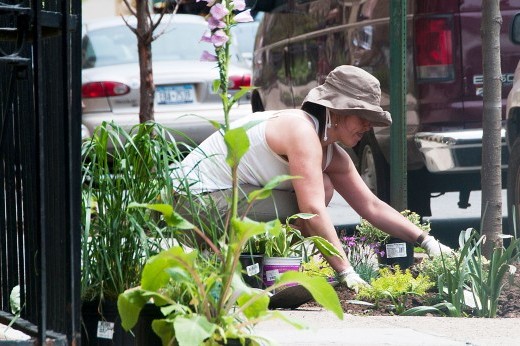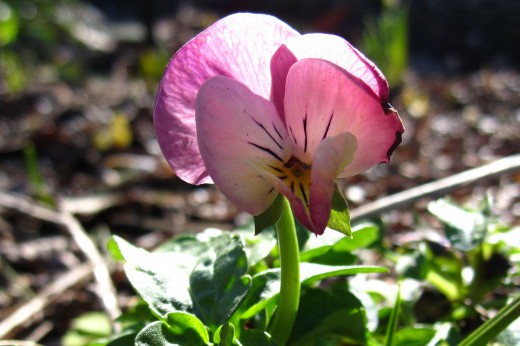Welcome to the first installment of Ask a Gardener, a seasonal gardening advice column written by Rock Garden gardener Laura Powell.
Whenever I buy a plant for my garden, the care tag says it needs “well-drained soil.” How can I tell if my soil is well-drained?
Ann, Brooklyn, NY
Dear Ann,
Having well-drained soil is important, because the roots of most plants need to dry out in between waterings or else they cannot get oxygen (yes, roots need oxygen!). There are some plants that prefer what gardeners call “wet feet”—aquatic plants, for example—but the majority of plants prefer well-drained soil.
So how can you tell if your soil is well-drained? There are a few ways:
- Look at your garden after it rains. If there are standing pools of water, you may have a drainage problem.
- Pay attention to your soil. Is it always moist and never dry? The top layer of soil should occasionally feel dry.
- Check out your soil texture. Well-drained soil typically has a loose, crumbly texture. Pick up a handful of soil from your garden and squeeze it tightly in your fist. If it falls apart when you open your hand, it likely has good drainage. If it stays stuck in a ball like a lump of clay, then you may have poor drainage.
If you find that your soil has poor drainage, the best way to improve it is to add compost or other organic matter like manure. Incidentally, compost will improve soil that has poor water retention as well, so it’s hard to go wrong by adding compost to your garden. When in doubt, compost it out!
To learn more about soil care, check out our handbook Healthy Soils for Sustainable Gardens.
I am getting a plot in a community garden this year. I would like to grow vegetables. Where do I start?
Kathy, Brooklyn, NY
Dear Kathy,
Congratulations on your new garden!
A good place to start is by getting to know the community at your community garden. Talk to the gardeners in the plots next to yours. They’ll be able to give you a lot of information about which crops have worked well for them. They can also give you advice about the watering situation at the garden, and share how they have overcome challenges like pest problems. And they can advise you on the best sources in your area from which to buy seeds, plants, and other gardening supplies.
If you can’t speak with your garden neighbors, do what you would do when starting any new garden: Assess the growing conditions on your site. In a larger garden, the site assessment would include items like the slope and the wind exposure, but those usually aren’t concerns in a community garden. For a community garden plot, focus on the soil and light conditions.
After assessing the soil drainage (see Ann’s question above), you may consider sending a soil sample to the urban soils lab at Brooklyn College to have it tested for lead contamination if you are planning on eating the vegetables you grow. (If you are planting in a raised bed with clean soil, there is no need for a soil test.)
Unfortunately, some of the soil in Brooklyn is high in lead, which can become absorbed by the plants we grow in that soil. The lab report will have more guidance about concerns specific to your soil sample. A soil report can also let you know if your soil is nutrient deficient. If that is the case, compost is an organic way to add nutrients to your soil.
After evaluating the soil, assess the light conditions of your plot. Do you have a sunny plot, or a shady plot? If it’s sunny, you can grow pretty much any herb or vegetable. If you have a shadier plot, you would be wise to stick to root and leafy vegetables for your first year. Fruiting plants like tomatoes usually need at least six hours of direct sunlight a day in order to produce a good crop.
Once you have evaluated the conditions in your plot, choose vegetables you like to eat that will thrive under those conditions. If you are starting early in the season, you can grow a succession of crops, planting cool season crops like peas and radishes in March, and then planting warm season crops like beans and zucchini in May.
Once your garden is planted, water and weed it regularly, enjoy the community, and when it’s harvest time, there is nothing more delicious than the taste of a vegetable you grew yourself. Bon appétit!
What can I plant in my tree bed that won’t be immediately killed by animal urine, variable watering, and trash?
Danae, Brooklyn, NY
Dear Danae,
Ah, the joys of urban gardening.
Before I answer your question, I would be remiss if I didn’t mention that some gardeners think nothing should be planted in tree pits other than trees. This is because any disturbance to tree roots (including planting) is potentially damaging to the tree’s roots, and anything you plant in the tree pit will be competing with the tree for limited water and nutrients. Keeping the tree pit free of weeds and debris and adding a three-inch layer of mulch (avoiding the base of the tree) is all you need to keep your tree bed tidy.
Other gardeners support planting in tree beds, because when people plant flowers in their tree pits, they are more likely to remember to water their trees—which is a net benefit for the tree, even if they need to share the space with the other plants.
The best precaution against animal urine is not urine-resistant plants, but having a tree guard installed. Call your local City Council member to ask if they have a program sponsoring the installation of tree guards, or you can contact New York Tree Time, who will install a tree guard in exchange for a donation. (Don’t forget to apply for a tree work permit.)
Before you put in any plants, you may need to improve the soil, which can get tightly compacted from foot and road traffic. Gently loosen soil compaction with a hand cultivator—this is a must for street tree care, even if you aren’t planting anything—and consider mixing in a thin layer of compost.
Now you’re ready for planting!
Spring bulbs are my go-to choice for tree pits as they generally don’t require large amounts of water and usually go dormant in the summer, so they will not be competing with the tree for water during the summer dry season. Hardy bulbs can be planted once and will come back every year, minimizing tree root disturbance. I prefer small bulbs like crocus, scilla, or Spanish bluebells, but larger bulbs like daffodils also make lovely additions to a tree pit. (Be aware of roots in the bed while planting—you typically won't want to dig deeper than three to six inches.)
But maybe you don’t want a plant that will go dormant for the summer? If not, you’ll want herbaceous annuals or perennials—not woody plants, which will compete with the tree. Look for plants that have low water needs so they will play nicely with the tree—“drought-tolerant” in a plant description can be a helpful clue.
Wild geranium (Geranium maculatum) is a tough plant that can withstand the occasional bit of trash and variable watering. It has attractive foliage and purplish-pink flowers in the late spring; as a perennial, you can enjoy it for years without replanting. Other perennials good for tree pits are Hakonechloa macra, Heuchera, and Tiarella cordifolia. If you’d like something more unusual, Cyclamen coum and Helleborus orientalis both grow well under trees.
If you would like a plant that has a longer bloom time than a perennial, and don’t mind replanting every year, consider annuals. Some annuals that are suitable for tree beds are impatiens, pansies, and coleus. Look for sun-loving annuals for young trees and shade-loving plants for larger trees.
A few don’ts:
- Don’t add soil to your tree pit. The tree has been carefully planted to be at the correct soil level, and additional soil can interfere with the health of the tree.
- In addition to avoiding woody plants, don’t plant any climbing vines like English ivy. These can climb up the trunk and shorten the life of the tree.
- Don’t plant ultra-aggressive plants like bamboo, because they may outcompete the tree and could also escape the tree bed.
- Whatever you do, remember: The tree’s health always comes first.
To learn more, check out the Garden’s tips for street tree stewardship, as well as NYC Parks’ latest recommendations for planting in tree pits. And thank you for being a steward of our city’s tree canopy. You’re helping all of us breathe a little easier.
Got a question for Laura? Submit questions for our summer installment of Ask a Gardener using the form below.



